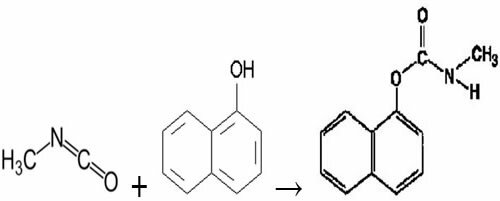In the manufacture of products in general, chemical reactions are used throughout the process, until obtaining the final product. And, of course, it wouldn't be different in the Insecticide Industry, follow the equation that represents the process of obtaining the Sevin insecticide.
Methyl isocyanate 1-naphthol 1-naphthol-N-methylcarbamate
(Sevin insecticide)
In 1984, a factory in the city of Bhopal, India, which used to produce exactly this insecticide, was responsible for one of the biggest accidents in history. At the time, the factory was stopped for renovations, but it had a stock of raw material, and an oversight caused the accident. A large amount of the highly toxic gas, methyl isocyanate, leaked from storage tanks and reached the local population. A cloud of gas covered the city and took its toll.
The harmful effects of the intoxication were immediate, people went out on the streets with breathing difficulties, vomiting blood and with totally impaired vision. The accident claimed fatalities on the same day it occurred and on the days that followed. Pregnant women had miscarriages and the children who were born during this period were unable to survive. It was a terrible chemical disaster.
It is for this and other reasons that the production of dangerous products requires extreme care on the part of manufacturers, both in transport and storage. Technological advances allow the handling of toxic products to be done in a safer way, all so that ethics and respect for others are maintained.
By Líria Alves
Graduated in Chemistry
Brazil School Team
See more!
DDT – toxic insecticide
Environmental Chemistry - Chemistry - Brazil School
Source: Brazil School - https://brasilescola.uol.com.br/quimica/gas-toxico-bhopal.htm

